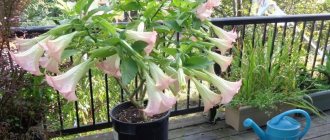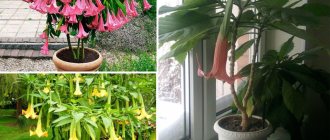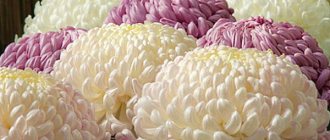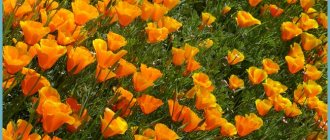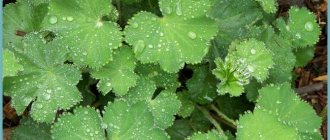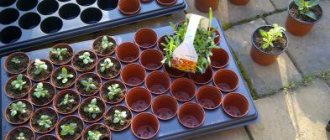Lighting
This is a light-loving plant that requires bright sunlight all year round.
Direct sunlight does not harm it; on the contrary, Brugmansia needs direct sun for several hours every day .
In winter, when there is not enough light and daylight hours decrease, the plant can stretch out and lose its decorative appearance. Therefore, it must be illuminated with electric lamps or the temperature of the contents reduced so that it does not grow.
Brugmansia: species, varieties and their description
The genus Brugmansia belongs to the large Solanaceae family and includes 5 species of shrubs. The plant is noteworthy for its huge flowers of white, yellow, hot pink and orange.
Nowadays many variegated forms of the flower have been developed that are not found in the wild. There are also various hybrids with cascading, double, split flowers.
Fortunately, despite its exotic origin, this shrub is very unpretentious.
In the middle zone, Brugmansia is a tub plant that should overwinter indoors. At home, the flower can bloom magnificently until the New Year.
- The most common among our flower growers are tree brugmansia and terry brugmansia.
- In addition, a variety called snow white is popular.
- Golden Brugmansia grows up to 8 meters in height.
- And the yellow one amazes with the brightness of the flowers against the green background of the foliage.
- Brugmansia blood-red grows the tallest in cultivation. It can reach 14 meters.
- The flowers of Brugmansia multicolored or variegated reach a diameter of 40 cm.
The soil
Brugmansia does not tolerate very acidic soil. The proportion of peat in the soil mixture for Brugmansia should be no more than 50% .
You can purchase soil for it at a flower shop: universal soil for flowering plants with or without the addition of peat is suitable.
If you prepare the soil yourself, the best composition will be a mixture of peat, humus and turf soil in equal parts. It is advisable to add sand or perlite here for greater looseness.
Before planting a flower, it is advisable to disinfect the soil by watering it with a weak solution of potassium permanganate.
Where to buy and cost of the plant
You can purchase planting material from nurseries or flower shops that specialize in selling flower plants. The cost of Brugmansia seeds varies between 48 rubles. The price for seedlings starts from 350 rubles.
If you follow the rules of planting and caring for Brugmansia, the flower will grow and develop normally at home over a long period of time. In this case, the bush will be covered with lush green mass and bright flowers.
Fertilizer
The plant needs to be fertilized only during the period of growth and flowering in spring and summer. Complex mineral fertilizers for deciduous plants are suitable for feeding before flowering. Feeding is carried out 2 times a month, starting in April.
After the buds appear, Brugmansia is fed with fertilizers for flowering plants. They are introduced into moist soil a few hours after watering.
After Brugmansia finishes flowering, feeding is gradually stopped.
It is recommended to feed Brugmansia with organic fertilizers 1-2 times a season.
Suitable for this purpose: diluted chicken manure, mullein, or purchased organic fertilizers for indoor and garden plants.
Use in landscape design
This beautiful flowering plant looks simply great when planted alone. An excellent background for Brugmansia is a lawn or carpet flower garden.
Brugmansia looks great in garden beds and on flower lawns. Bushes with drooping flowers will decorate a hedge. Many gardeners place tubs of flowering plants in the yard to decorate their garden plot.
Do not forget that this bush is dangerous, since its juice is poisonous. Children should not be allowed to engage in Brugmansia. But otherwise, the exotic guest is not so demanding to care for; on the contrary, it delights and is remembered by its large, fragrant flowers.
Peculiarities
In summer, the plant feels best outdoors. It is advisable to take it out into the garden, onto the terrace or onto the open balcony during the entire warm period.
In winter, Brugmansia requires a cool hibernation . As the air temperature drops, the growing season decreases more and more. Therefore, the lower the temperature of the plant, the weaker the lighting can be.
If the plant is kept at a temperature of about 8-9ºС, it does not need bright light, since in such conditions it does not grow or stretch. If it overwinters at a higher temperature, it needs good lighting.
All parts of Brugmansia are poisonous. Brugmansia should not be placed in children's rooms or in places where pets can reach. It is advisable to carry out all work with it wearing protective gloves.
We reveal the secrets of caring for Brugmansia
- VK
- Youtube
Do you look with admiration and envy at the Brugmansia blooming profusely in your neighbor’s garden? So, this tub plant blooms throughout the summer with a lush fountain of huge, slightly drooping tubular-bell-shaped flowers of divine shades, but in order to achieve such excellent flowering, you need to know and skillfully apply some very useful tricks.
Flower pots and soil
In a pot that is too small, Brugmansia suffers from drying out soil, as its drooping leaves will tell you. Young plants should be replanted every spring into a new pot with a diameter 2-3 cm larger than the previous one. For this tree-like shrub, which is also called angel trumpets, plastic pots are best suited rather than clay or terracotta: because the root system in them grows more evenly, and thin roots do not grow to the walls. It is very important to make drainage holes in the bottom of the container through which excess water escapes.
The large leaves of Brugmansia evaporate a lot of moisture, and when there are gusts of wind, they lose their balance and can easily break off. Therefore, it is worth choosing a large enough tub for the plant that can hold more water and be quite stable. Large stone tubs are highly prized. On the bottom, in which holes are made to drain excess water, pour a layer of expanded clay. When growing Brugmansia, use regular soil for tub plants. The further development of the plant is very favorably affected by the addition of some clay granules to the soil, which conserves moisture and nutrients. If in doubt, enrich the substrate with clay granules or expanded clay at the rate of 10% of its total volume.
Brugmansia 'Feuerwerk' (Brugmansia sanguinea) in a tub made of plastic imitating the texture of stone casting
Tip: in summer Brugmansia should be planted directly in open ground in the garden. This way, your flowering shrub will be more evenly supplied with water. However, before the first frost, the cold-sensitive plant must be carefully dug up and planted in a tub, placing it in a place protected from frost for the winter. Digging up the roots every year does not harm the plant.
Ideal location
In spring, Brugmansia should be left in a slightly shady place for some time (3-4 days) so that it can get used to intense sunlight. Our angel trumpets will then be able to withstand even direct sunlight. A sheltered from the wind, very bright, but shaded from the midday sun place in the garden or on the terrace is ideal. Diffused shade for the plant is created, for example, by tree crowns or lace umbrellas.
Abundant watering
Brugmansia, with its large, oval-elongated, slightly pubescent leaves, consumes an extremely large amount of water. Therefore, in summer it is necessary to water the plant at least once, and on hot days - even twice a day. Water until excess water comes out of the drainage holes and into the pan.
Fragrant Brugmansia 'Frosty Pink' (Brugmansia suaveolens). In nature in its homeland, in southeastern Brazil, it reaches up to 5 m in height
Generous feeding
Brugmansia, like almost all members of the nightshade family (Solanaceae, which includes, for example, tomatoes and tobacco) is a strong consumer of nutrients. And the key to their long and abundant flowering is regular and generous feeding. Therefore, already in the spring, during replanting, long-acting fertilizer should be mixed into fresh soil for balcony or tub plants. In addition, from May to August, feed your beauty once or twice a week with liquid fertilizer for flowering plants, adding it to the water for watering. And you can be completely calm, in the case of Brugmansia, oversaturation with fertilizers is almost impossible! The experience of many amateur gardeners shows that good results can be achieved with the help of conventional mineral fertilizer, for example Blaukorn. Dissolve two heaped tablespoons in 10 liters of water for irrigation. At the end of August, all feeding should be stopped, which will stop the growth of the plant and contribute to the lignification of the shoots.
Garden bench framed by abundantly flowering Brugmansia bushes
Pruning: pay attention to the shape of the leaves
During the period when Brugmansia is in the open air, it, in principle, does not need pruning, since the plant branches well and forms a sufficient number of flower shoots. In the winter apartment, our angel trumpets, due to lack of light, send out mostly thin, few-branched shoots with small, pale green leaves. Such shoots should be shortened in the spring, leaving only 1-2 asymmetrical leaves. The plant produces flowers above Y-shaped branches called “forks.” The flowering zone can be determined by the base of the leaf: a symmetrical leaf indicates the growing zone, and a ledge at the base of the leaf indicates the beginning of the flowering zone. In the fall, Brugmansia is pruned so that it does not take up too much space in the winter apartment. Attention: trim the plant so that at least one asymmetrical leaf remains on one flower shoot. Trimming shoots to leave only symmetrical leaves will delay flowering next season.
Advice: after pruning, in the fall, do not immediately transfer the plant indoors for wintering. Leave the cut brugmansia for several days on a warm terrace to allow the fresh cuts to dry.
The flowering areas of the shoots have asymmetrical leaves (leaf on the left). In the zone with symmetrical leaves, that is, leaves of the correct shape (leaf on the right), flowers do not form. When pruning a plant, you should not leave only symmetrical leaves.
Common diseases and pests
Brugmansia is almost not susceptible to diseases, but can be affected by various pests, for example, weevils. Beetles can be very easily recognized by their characteristic, semicircular, eaten away areas along the edges of the foliage. Snails also love to eat soft, fleshy leaves. In addition, Brugmansia is often affected by spider mites. As a rule, plants that are kept in poorly ventilated areas all year round suffer from it.
Wintering
Brugmansia is left to overwinter in a bright, cool (about 10-15°C) room. This could be a winter garden. In such conditions, the plant completely retains its leaves and continues to bloom for some time - which is not given to everyone due to flowers that have an intense aroma. Some gardeners place Brugmansia in a dark place for the winter. In any case, the air temperature should be, if possible, stable around 5° C. In such conditions, the plant sheds almost all its leaves, but recovers very quickly in the spring. In a dark, cold room, brugmansia is watered so that the roots do not dry out. If the plant overwinters in a bright room, then it should be watered more and checked for pest damage more often.
Several amazing Brugmansia varieties from the private garden of Monika Gottschalk, Germany
| Abundantly blooming Brugmansia (Brugmansia x cubensi)s 'Edna' with bell-shaped, drooping, double flowers of medium size (27 - 29cm), painted in a delicate white-pink color. | The charming Brugmansia (Brugmansia x cubensis) 'Fandango' amazes with its bell-shaped, white flowers with a peachy bloom. To prolong abundant flowering, Brugancia should be in partial shade in a place protected from the winds. |
| Brugmansia x candida 'Marie Stöppler' with large (30 – 33 cm), drooping, double bell-shaped flowers of soft pink color. | Snow-white Brugmansia "Brugmansia x candida" 'Diebsteinperle' with double, drooping bells (30 - 33cm) of a peculiar shape. Abundantly flowering hybrid. |
Large (30 – 33cm), very beautiful drooping flowers with a wide corolla of Brugmansia x candida 'Luise'. The color of the flowers is cream with an apricot bloom.
Translation: Lesya Vasko especially for the gardening internet portal
Publication date: July 22, 2010
comments
Lesya Vasko
If you notice an error, select the required text and press Ctrl+Enter to report it to the editors
Comments:
There are no comments yet, you can add your own comment. For this you need to register or log in.
Authorization
You have entered an incorrect login/password
adding a comment
Useful articles
- Studio LoraShen
Diseases
The most common disease of Brugmansia is gray rot, which affects leaves, shoots and trunk. Also, sometimes the plant suffers from root rot. These diseases appear only when the plant is not watered correctly, when water stagnates in the soil or in the internodes of the branches. It should be remembered that excessive moisture can destroy the plant.
If fungal infections have not spread throughout the plant, you can trim the diseased branches to healthy tissue, and collect and destroy the rotten parts. In case of root rot, the plant is kept without watering for about a week so that the soil dries out, and then they begin to water very moderately.
Brugmansia can be parasitized by many pests: spider mites, whiteflies, thrips, aphids, caterpillars and slugs. Slugs must be collected by hand.
Insecticidal preparations that need to be sprayed generously on the plant will help against other pests. If necessary, the treatment is repeated after a week.
Problems
This plant is considered unpretentious, however, it can suddenly become ill and die. Problems arise when growing Brugmansia even among experienced gardeners. Most often, it is not possible to achieve flowering of the plant, or the buds that appear begin to fall off.
Brugmansia usually does not bloom due to insufficient lighting . At the same time, its shoots weaken and become thinner. Flowering can also be affected by lack of nutrients.
To get a flowering tree, it needs to be regularly fed and replanted in new soil.
Buds fall off for several reasons. They may suddenly fall off due to a sharp drop in air temperature. They also fall off if the plant lacks moisture.
You cannot move Brugmansia with buds to another place: due to changes in lighting, it may drop the buds.
Reproduction
Brugmansia is propagated by seeds and vegetatively. Growing from seeds is not a very popular propagation method, as it is a labor-intensive and time-consuming process, and a flowering plant can only be obtained after 3 years.
Seeds are sown in containers with moistened soil, covered with film and kept at a temperature not lower than 22ºC for at least 1.5 months. Over time, the sprouts dive into separate pots.
Vegetative propagation method is the most common . Cuttings are harvested in the spring during annual pruning. They are rooted in water or soil.
When rooting in water, they are placed in boiled water until roots form, and then planted in separate pots with soil.
When rooting in the ground, the cuttings are buried in pots with perlite or sand and covered with glass jars. Usually, 100% of the cuttings take root.
Transfer
This large plant needs to be replanted every year or even twice a year in the first 2-3 years of its life. Its root system grows quickly, so the flower is transplanted by transferring it into a larger pot. Transplantation can be carried out in the spring before the beginning of the growing season and in the fall before the start of wintering.
Adult Brugmansias after 3 years of age are replanted every 2 years.
A thick drainage layer is placed at the bottom of the pot so that water does not stagnate in the soil. Transplantation is carried out using the transshipment method.
Do not replant very large and old plants growing in tubs that, due to their size, cannot be removed from the pot. In this case, the top layer of soil in the tubs is replaced with fresh fertile soil twice a year.
